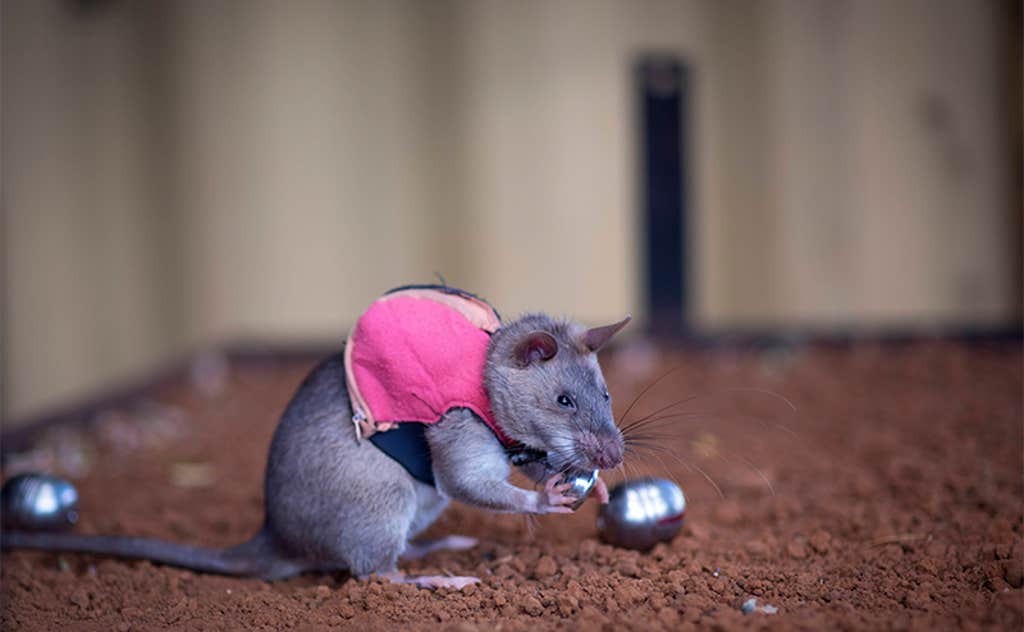Not all heroes wear capes. Some wear little vests and fight crime with powerful noses. While scent detection dogs have been around for decades, these particular heroes are African giant pouched rats (Cricetomys ansorgei)—and they could be an important force in the fight against the illegal wildlife trade.
Colloquially known as “pouchies,” African giant pouched rats are large, mostly nocturnal rodents native to the African savanna. They can weigh up to four and a half pounds and are named after the pouches in their cheeks that they use to carry food back to their colonies for storage. They also have exceptionally powerful noses: The species’ olfactory bulbs account for 19 percent of total brain length. For over 20 years researchers at APOPO in Tanzania have been training the pouchies to sniff for stuff, including dangerous landmines and the pathogen that causes tuberculosis. (In both cases, researchers have found that the rats can complete four days’ worth of human work in about 30 minutes.)
Now new research shows pouchies can be effectively trained to detect illegally trafficked goods as well, including rhino horn, elephant ivory, pangolin scales, and even African blackwood, a highly coveted and endangered tree species. Through positive-reinforcement training—bites of tasty banana, avocado, and crushed chow pellets delivered through a food syringe—8 of 11 rats successfully learned how to remember and indicate target scents and ignore non-target odors.
Each “hero rat” has a proper name—like Attenborough, Irwin, Ebony, or Betty.
“We’re big believers that the rats can fill an important role in basically any scent detection test,” says Kate Webb, a neuroscientist, researcher, and co-author of the study, which was published in Frontiers in Conservation Science. “Anything a dog can do, we think the rats can do, with the potential added benefits of affordability, trainability, and transferability between handlers.”
Compared to most working dogs, African giant pouched rats are tiny. Weighing an average of 3 pounds, these diminutive decoders are easier to transport and are more versatile for use in searching small spaces. They’re also more affordable to house, feed, and train, with most rats ready for the field within eight to 11 months after training begins. Detection rats cost between $6,000 and $8,000 to train and deploy, versus $10,000 to $30,000 for detection dogs, says Webb.
This doesn’t mean that rats will be making the rounds at airports and shipping harbors just yet. While the proof-of-principle study was successful—the rats were able to reliably discriminate the target scents from 146 non-target substances, such as peanuts, coffee grounds, electric cables, and synthetic wigs—it took place in a controlled environment. Since the conclusion of the study, however, the APOPO team has conducted two rounds of operational trials at the port of Dar es Salaam, in Tanzania. “Both trials went very well,” says Webb.
One challenge the team may face—particularly in airports—is fear of rats in the general population. Guide and scent-detection dogs are easy to love and widely accepted in high-security situations, but some folks might not welcome a large rat crawling atop their luggage. But it might help that each “hero rat,” as APOPO refers to them, has a proper name—like Attenborough, Irwin, Ebony, or Betty—many of which are chosen to honor wildlife conservationists and anti-trafficking advocates. And then there are the vests.

The vests are lightweight and fitted with a small ball, which the rats are trained to tug with their front paws when they’ve detected a target scent. This serves as a clear indication to handlers—and it’s cute, even to the scientists. Webb acknowledges that rats are often associated with filth, and hopes that the “cute vests, with their names, will have an added benefit of improving public image.”
Whether they can garner public affection or not, the evidence that African giant pouched rats are capable of helping authorities combat biodiversity crimes is compelling. But the rats—along with dogs, scanning machines, AI, or any other form of detection technology—can only do so much. None of these tools stop the illegal wildlife trade at its source: Humans.
“I think it’s really important to look at the push factors and reasons why people will engage in this industry to begin with,” says Runako Celina, an investigative journalist, documentary filmmaker, and the host of Luminary podcast Pull the Thread: The Wild Life, which examines the illegal wildlife trade and people closest to it. “I hate to make generalizations, but in some instances it’s not having another way to feed your family,” says Celina. “There are so many other factors—and nowhere along the course of our investigation did the fact that it was ‘easy’ or that you could do something without being detected feature in the reasons for people engaging in the trade. I’m sure detection measures have their role, but do I think they will deter the majority? Absolutely not.”
This multi-billion dollar wildlife trafficking industry won’t be snuffed out overnight. To Celina’s point, additional research has found that the threat of legal punishment is not enough to deter those involved in wildlife crimes. It’s unlikely that APOPO’s hero rats alone will stop this trade, but they could at least help authorities put more paws on the ground.
“We certainly weren’t setting out to replace X-rays or the port authorities or the dogs that are already deployed,” says Webb. “We just think that the rats can serve an important and complementary role to fight against the illegal wildlife trade.” ![]()
Lead photo courtesy of APOPO
































